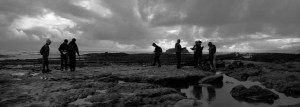It was the renowned West Coast rain which put us to sleep that first night. The next day, puddles of the wet stuff lay everywhere and in some places spanned the entire road width. Low tide was at 11:52am so about an hour beforehand we set off to 12-mile beach to look at the lower part of the Paparoa Coal Measures (Cretaceous). Apart from one rain/hail shower, we examined the outcrop in relative comfort.
Every year I teach a 5-day coal and petroleum course (GEOL483) at the University of Canterbury field station in Westport (West Coast, South Island). This year I had 17 students, all of whom are doing either MSc or Honors degrees. Two primary/secondary school teachers (Ali and Carrie) were along to help out and see how geology is taught at University level.
The course is arranged so that some time is spent with me lecturing and other times we are all in the field looking at rocks/measuring sections or doing labs back at the field station. Its an intensive 5 days but I think it works as I have the full attention of the students during this time.
The readings this year were two articles on the shape of coal bodies (Fielding, 1984; Weisenfluh & Ferm, 1984) and a series of papers on the Permian/Triassic extinction event and the apparent coal gap during the lower Triassic (Retallack et al., 1996; Retallack and Jahrens, 2008; Grasby et al., 2011; Hamad et al., 2012). The readings are as much about learning to think and evaluate in a critical fashion as much as learning specific concepts.




Comments are closed.